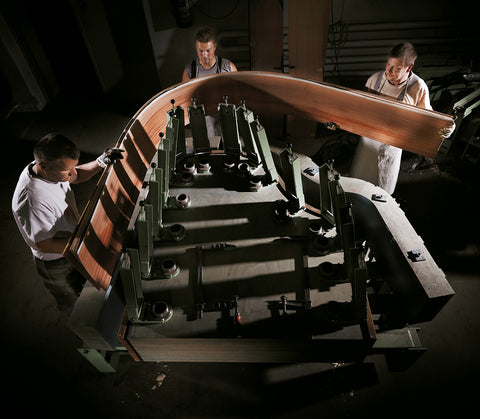
Quality of European pianos
The development of the piano and grand piano has been largely a European affair and the world's best pianos and grand pianos are still built in Europe (particularly in Germany and the Czech Republic).
European pianos and grand pianos are more durable and have soundboards that produce an overtone and more colorful sound than Asian ones. The European piano and grand piano mechanisms are also still unsurpassed in terms of quality, because they are more stable and offer greater dynamic controllability than the Asian ones.
A colorful sound together with the greatest possible variation in loud and soft (Pianoforte) determine the extent to which the intentions and emotions of the music can be conveyed.
The enormous number of Asian instruments is largely the result of mass production, while a lot of time is invested in European instruments, even today.

The differences between European and Asian pianos and grand pianos can be noted and checked in terms of construction aspects as well as material quality and/or choice of materials.
For example, German hammer heads are used in European instruments.
Hammerheads are the basis of every sound because they pick up the sound and direct its intensity via the bridge to the soundboard. C. Bechstein, for example, even produces its own hammer heads for all its piano and grand piano models! These are made of 100% natural wool (Wurzen felt, named after the town of Wurzen near Leipzig) and are stretched around the mahogany core using a low-pressure process. The vast majority of pianos and grand pianos produced in Asia, on the other hand, make hammer heads with artificial wool, which is stretched around the hammer core under high pressure and to retain moisture in the hammer head felt in a warm climate, they are impregnated with lacquer. The tone of a piano or grand piano with impregnated hammers is more uniform/one-sided and therefore has less soul/character and fewer intonation possibilities.
The high-quality Renner machine heads used in European instruments (C. Bechstein, Steingraeber & Söhne, Fazioli, Steinway, Bösendorfer) use the most modern CNC (computer numerical control) machines, which guarantees perfect machine tool production.
Did you know that you can buy a C. Bechstein piano from € 11,990, while other Do you not produce top European brands in this price range?

A very important part of pianos and grand pianos is the soundboard, which actually functions as a natural (wood: at the back of the piano or inside of the grand piano) speaker.
There are also clear differences between European and Asian productions in this area.
European soundboards use Norway spruce from the Alps, Bohemia or Ciresa wood (Val di Fiemme, Italy), which was also used for the soundboards of Stradivarius violins. The European wood is selected at the tree line (at an altitude of 1800 to 2200 meters), after which the sawn wood is seasoned. After approximately 6 months, a lengthy and careful drying process follows. Drying takes place under low heat to ensure that the wood is not damaged.
The Asian soundboards are largely made from Sitka spruce (west coast North America, planted in England & Ireland, Alaska and Siberia) and are selected for similarity, followed by a significantly shorter drying process.
Asian productions vary in numbers between approximately 10,000 and 100,000 pianos and grand pianos per year (mass production) and the professionals have a 45- or 50-hour working week.
European productions involve annual quantities of between approximately 500 and 5,000 instruments and a 38- or 40-hour working week.
Finally, we note that the sound ideal in Europe and Asia has always differed from each other.
With European pianos and grand pianos you are always assured of European professional intoners who perform the time-honored craft in the tradition originated and developed in Europe.




